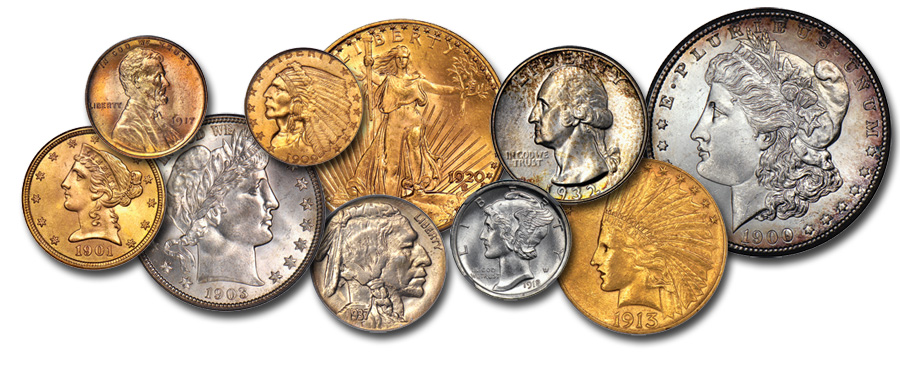
Welcome to the second installment of my four-part series on building a 20th-century type set, including one of each design used in circulation from 1900 to 1999. This week I will continue with nickel five-cent pieces, followed by dimes and quarters.
Nickel five-cent pieces of the 20th century commence with the Liberty Head type from 1900 through 1912. These are easily enough obtained in Mint State, slightly more difficult in Proof format.
Next follows the Indian Head or Buffalo nickel by James Earle Fraser, launched in 1913. The first coins of the year had the bison standing on a raised mound. This was soon modified, isolating the 1913 Type I Buffalo nickel as a distinct type.
Later in the year the Type II Buffalo nickel with the bison on a level field was introduced and was continued through the end of the series in 1938. Today this series is high on the list of all-time favorites of collectors.
In 1938 the Jefferson nickel, designed by Felix O. Schlag made its debut. This was continued through the end of the 20th century.
A change of type occurred in 1966 when the designer’s initials were added on the obverse below the portrait. Accordingly you will want a 1938 to 1965 nickel and the type of 1966 to 1999.
In the meantime, during World War II a new alloy was introduced for the Jefferson nickel, composed of 56% copper, 35% silver, and 9% manganese. These were distinguished by having the mintmark, including the first appearance of P for Philadelphia on the reverse, above the dome of Monticello. Production was from 1942 through 1945. When first minted the coins had a bright silvery appearance. However, once in circulation they became quite dull. Examples are easy enough to obtain today.
Silver coins come next, beginning with the Barber or Liberty Head dime by Charles E. Barber, 1900 to 1916. Many different dates and mintmarks are available, most of them inexpensive.
The next type was the Winged Liberty Head or “Mercury” type by Adolph Weinman, launched in 1916 and minted continuously through 1945 with the solitary exception of 1922. Examples are easy enough to find and are very attractive in Mint State. Proofs were made from 1936 through 1942 inclusive.
The Roosevelt dime, by John R. Sinnock, made its appearance in 1946 and was continued without change through 1964. Select the variety of your choice. There are no rarities.
In 1965 the rising price of silver mandated a change, and a clad alloy was used from that time forward for the final 20th century dime type.
Quarter dollars come next, beginning with the Barber or Liberty Head type from 1900 through 1916 inclusive, with many dates and mintmarks to choose from.
Hermon A. MacNeil’s Standing Liberty quarter was next, Type I with Miss Liberty mostly bare above her waist, minted in 1916 to the extent of only 52,000 pieces plus a generous mintage in early 1917. The 1917 issues usually come with a needle-sharp strike and are very attractive.
MacNeil decided to change the coin in 1917, dressing Miss Liberty in a coat or mail or armor, reflective of the Great War going on in Europe, which the United States joined in 1917. The Type II design was produced continuously from 1917 through 1930 with the solitary exception of 1922. Examples of some of the more available issues are inexpensive. Striking can be a problem and a super rarity for any mint would be a coin that has a full head on Miss Liberty and also sharply defined rivets in her shield.
Washington quarters are next for a type set, designed by John Flanagan and minted in silver from 1932 through 1964, except for 1933.
In 1965 the rising cost of silver caused a new clad alloy to be used beginning with that date and continuing through 1999. Such pieces were minted in 1975, but did not bear the 1975 date as the Mints were busy pre-striking Bicentennial coins.
The 1776-1976 double-dated Bicentennial coins are the next type, made for only a short time. This was one of three denominations for the celebration and, in the view of many numismatists, had the most attractive reverse — a colonial drummer boy.
In 1999 the first Statehood quarters were launched, to be produced at the rate of five different per year. Harvey Stack was the leading light influencing Congress to produce “commemorative” quarters that instead of being priced at a sharp premium would be placed into circulation at face value. The program was immensely successful, far beyond the expectations of everyone. There were five different states honored in 1999: Delaware, Pennsylvania, New Jersey, Georgia, and Connecticut.
See you next week, starting with half dollars.





